Menu
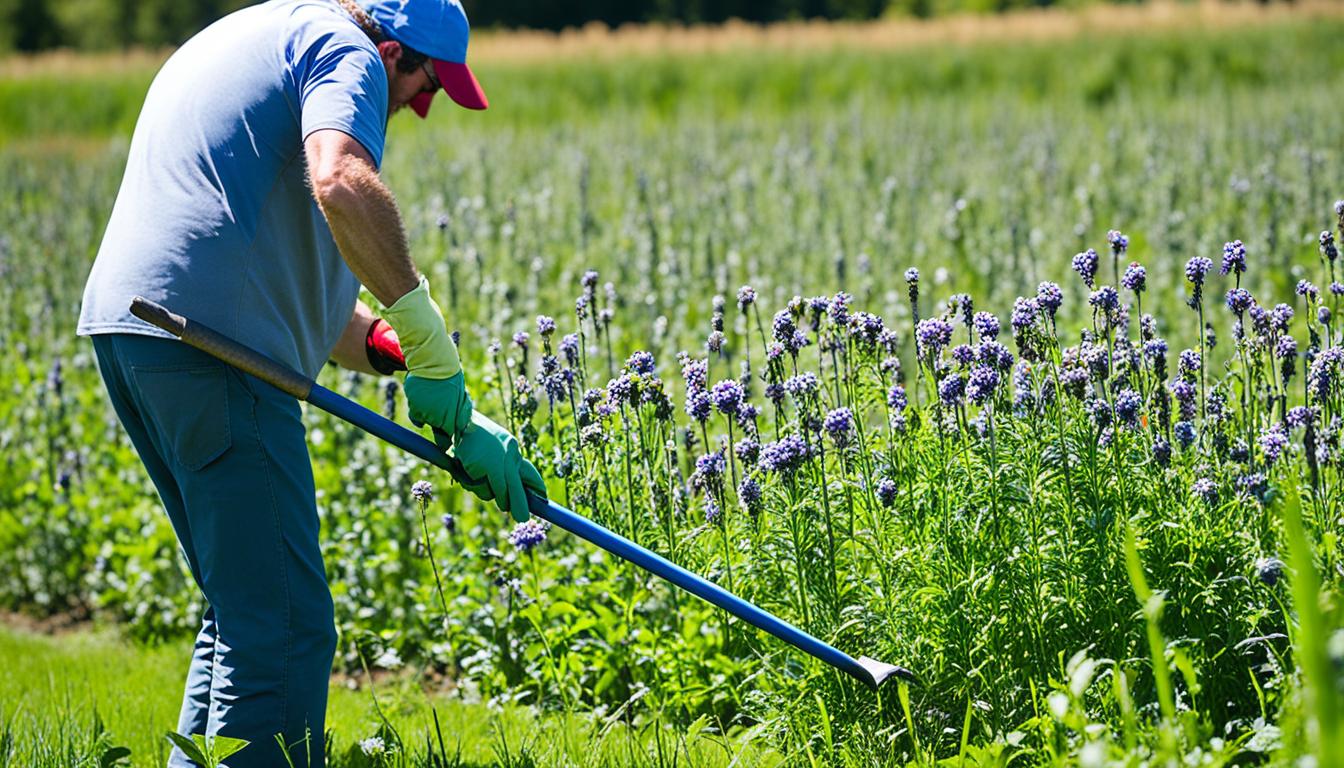
Did you know that not giving weeds water can reduce their growth by 50 to 70 percent? This fact shows how important it is to have good strategies for summer weed control. Summer brings high heat, not much water, and stronger weeds. Dealing with weeds in the summer needs smart, varied methods.
I want to share tips for getting rid of weeds effectively in summer. We need to understand the problems summer’s heat creates. It affects how well weed killers work and the health of your grass. So, we should use not only weed killers but also techniques that make your lawn strong against weeds.
Summer presents tough challenges for weed management. The weather changes a lot, making it hard to predict. Some weeds really love this time, like foxtails, fall panicum, and large crabgrass.
It’s important to know that these weeds start growing in spring. They get bigger in summer and then drop their seeds in the season’s end. To stop these weeds, you need a plan just for summer.
There are also weeds that come back every year, such as dandelions. They spread their seeds and roots around, making them hard to kill off. For these weeds, using special weed-killers that move to the roots works well.
Each weed type needs different care. The weeds that grow and seed fast need to be stopped early. But, those that grow from bulbs and tubers, like yellow nutsedge, need another approach. You have to focus on when they’re growing to really control them.
Some weed seeds stick around for years, waiting for the right moment to grow. For example, common chickweed can even sprout under snow. This can make managing them very tricky, especially in summer. Knowing this helps make a solid plan to keep them at bay.
| Weed Type | Lifecycle | Management Strategy |
|---|---|---|
| Foxtails | Annual | Pre-emergence herbicides in spring |
| Dandelions | Perennial | Postemergence herbicides at flowering |
| Giant Foxtail | Annual | Consistent mowing to prevent seeding |
| Yellow Nutsedge | Perennial | Herbicides that target tubers |
Summer weeds vary, making it key to know them well for control. They grow depending on where you are and the climate. Learning about their traits and growth helps us deal with them better.
Crabgrass and yellow foxtail are usual in the summer. Crabgrass grows close to the ground but can get up to 2 feet high. It loves the sun and dry weather, staying strong throughout summer. It can become 18 inches tall and wide, popping up in lawns, gardens, and more.
Yellow foxtail stands out with its short, fuzzy end and flat, red-stem base. Knowing these signs helps control it.
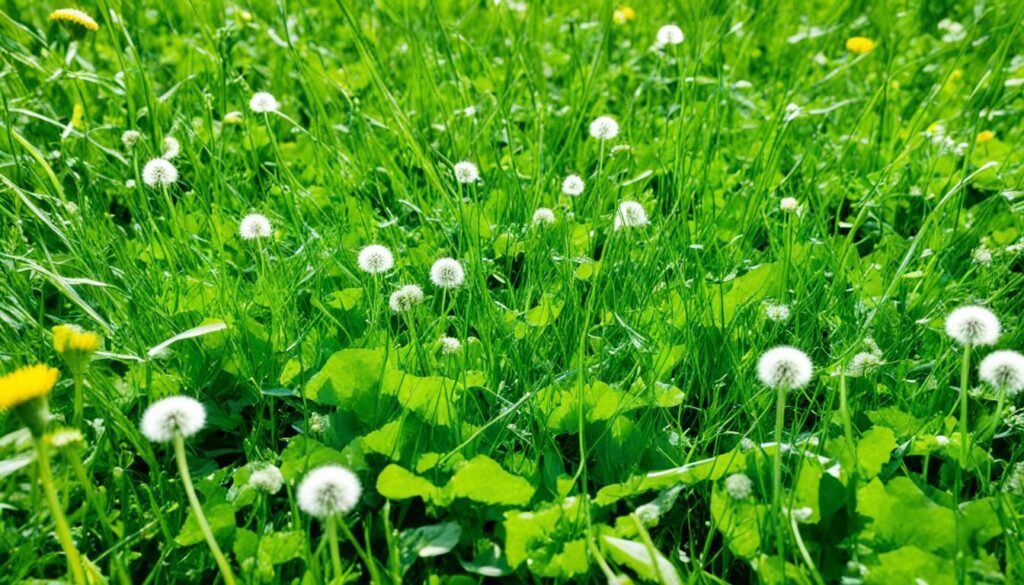
Yellow nutsedge is a type that comes back each year. It’s hard to get rid of. In some areas, it beats the locals in lawns and sports fields because nothing eats it.
Stopping its tubers from growing is key, especially in late June and July. Acting quickly is crucial against this tough plant.
| Weed Type | Example | Characteristics | Growth Conditions |
|---|---|---|---|
| Annual Grass | Crabgrass | Low-growing, membranous ligule, round stem | Warm, dry conditions |
| Annual Grass | Yellow Foxtail | Short, hairy ligule, flat stem with reddish base | Sunny areas |
| Perennial Sedge | Yellow Nutsedge | Robust, competitive growth, lacks natural enemies | Transition zones, warm-season lawns |
To stop weeds in summer, use herbicides before they sprout plus methods to change the growing environment. This combo slows weed growth and makes your area less weed-friendly, even before a single weed can pop up.
Start in spring with pre-emergent herbicides to halt summer weeds. Try Hi-Yield Atrazine or Crabgrass Control Plus. They stop weed seeds from growing by making a shield in the soil.
Apply these herbicides before weed seeds begin to sprout, usually at 55°F soil temperature. Mixing 3.2 oz of Bayer Advanced in a gallon of water treats 500 Sq Ft, covering well for prevention.
It’s clever to put herbicides down when it’s cooler, like in the evening under 90°F. This way, the chemicals don’t evaporate and work better.
Keep up with mowing to cut down on seeds and let strong grass beat out weeds. Good soil is a must too. Regular aeration and fertiliser help grass grow strong, fighting off weeds.
Another good move is using mulch. It keeps soil moist and dark, which weeds hate. Organic mulches improve soil as they break down.
Take weeds out by hand or with the right tools, especially in the hottest months. Pulling them out completely keeps them from coming back. Tools like weed torches or pullers can make this job easier.
Combining herbicides and good practices is the best way to prevent summer weeds. This method gives you a greener, sturdier lawn without the hassle of constant weeding.
Keeping weeds under control is key in farming. The US loses 10 to 12 billion dollars yearly because of them. Thus, picking the right herbicide is critical. You must know the difference between selective herbicides and non-selective herbicides.
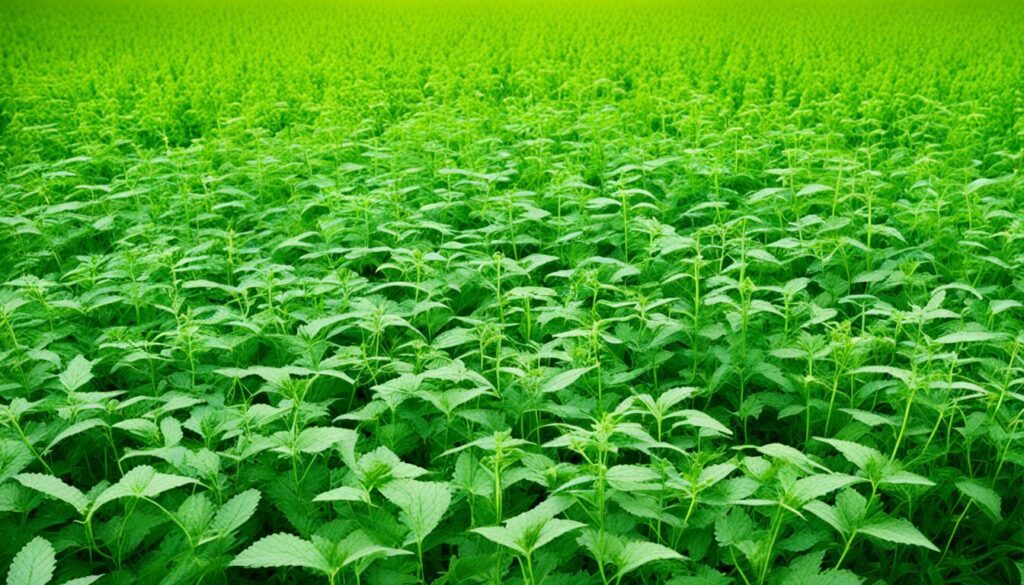
Selective herbicides kill only certain weeds, saving the wanted plants. They are great in places where you need to protect some plants while getting rid of others. For example, in soybeans or corn, they keep the main crops safe from harm.
On the flip side, non-selective herbicides kill everything. They’re good for clearing whole areas, like walkways or empty plots. But, you must be precise to avoid damaging good plants nearby.
Knowing the common active ingredients helps you make smart choices. Ingredients like 2,4-D, quinclorac, and dicamba work against various weeds. Their effectiveness changes based on the plant and setting.
| Herbicide Type | Active Ingredient | Application Method | Use Case |
|---|---|---|---|
| Selective Herbicide | 2,4-D | Postemergence | Targets broadleaf weeds |
| Selective Herbicide | Quinclorac | Preemergence | Controls crabgrass |
| Non-selective Herbicide | Dicamba | Postemergence | Total vegetation control |
The type of herbicide matters, as does how it’s made. There are emulsions and powders, both perfect if mixed right in water. This mix ensures the herbicide works well, keeping weeds at bay for a long time.
Choosing between selective and non-selective herbicides depends on your weed plan. Picking the right herbicide can reduce big losses and keep your plants healthy.
It’s tricky to apply herbicides in summer, but it’s doable with the right approach. Knowing how air temperature affects herbicide action is key. for best results, use most herbicides when it’s between 65°F and 85°F. If it gets hotter, especially 80°F and above, some herbicides might not work as well. This could damage your grass and make them less effective against weeds.
To keep your lawn safe and make herbicides work better, apply them when it’s cooler, like in the evening. It’s a good idea, especially if it’s very hot during the day. Also, check the product labels beforehand. Different herbicides need to be applied in specific temperatures for them to work well. For example, if you’re using fenoxaprop (Puma) against wild oat, it does better in cooler weather.
When the heat is on, make sure to mix your herbicides right. A good mix for high temperatures includes full-rate quinclorac and 1/3 rate Eliminate, with a wetting agent. This mix is great for dealing with clover, spurge, and crabgrass. It gets rid of weeds but is gentle on other plants.
Rainfall within six hours post-application can significantly diminish the effectiveness of some post-emergence herbicides, necessitating careful planning around weather forecasts to ensure efficacy.
By following these tips, you can master weed control in summer. This way, your lawn stays healthy and free of weeds even when it’s scorching outside.
Dealing with annual grass weeds in the summer is tough but crucial for a lush lawn. Weeds like crabgrass and annual bluegrass grow fast, outcompeting grass like Bermudagrass. They need quick and specific post-emergence strategies to keep them in check.
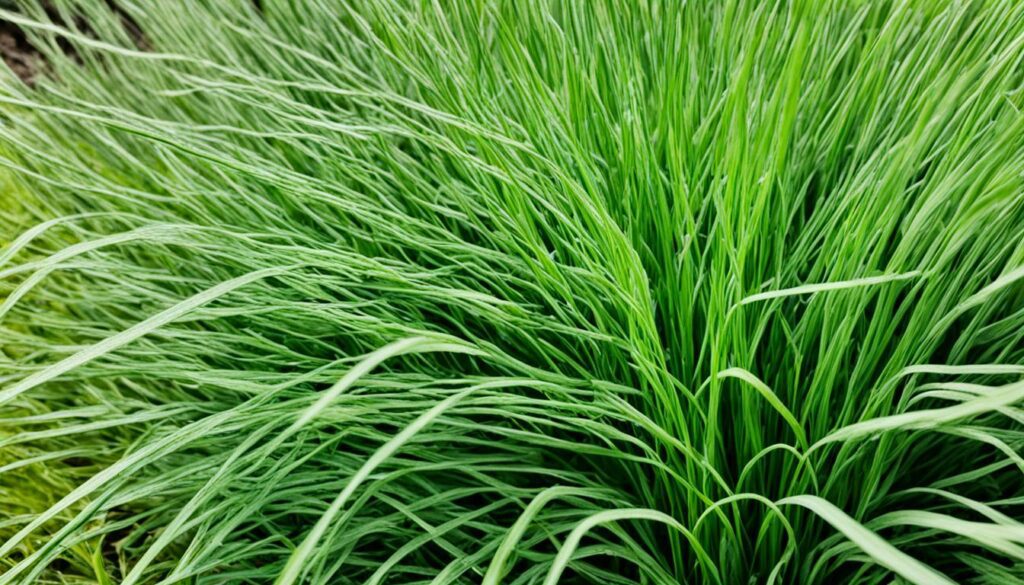
Early spotting and fast action against these weeds work best. Use post-emergence herbicides early on when the weeds are young. Substances like 2,4-D are great as they kill broadleaf weeds but leave the grass unharmed.
If you have a new lawn, be careful with herbicides in the first year. Try to use them sparingly or not at all until your lawn is strong.
| Weed Type | Characteristics | Control Measures |
|---|---|---|
| Crabgrass | Comes in two kinds and spreads quickly. | Use post-emergence herbicides like fenoxaprop-ethyl (Acclaim) to control. |
| Goosegrass | Grows a bit late than crabgrass and looks silvery-green. | Combine good mowing with herbicides to tackle it. |
To control perennial weeds in summer, we need specific tactics. These strategies focus on the weeds’ ability to come back each year. They survive the winter beneath the ground through parts like rhizomes and tubers.
Systemic herbicides work well against these stubborn weeds. Herbicides with 2,4-D, dicamba, and triclopyr help stop them from growing back. It’s best to use them from early September to October.
Examples of effective herbicides include 2,4-D (in products like Weed-B-Gon) and triclopyr (in Crossbow). They kill plants from the inside out. This process stops Canada thistle, milkweed, and quackgrass.
It’s important to keep an eye on the garden. Pulling out young weeds every two weeks can stop a big problem. Mulching also helps a lot. A 1-inch layer of mulch reduces the need for chemicals.
For some weeds, you’ll need specific treatments. Take yellow nutsedge, for instance. It’s best to use products like Segment, which handle grasses well.
There are special herbicides for grasses on broadleaf plants, too. Acclaim and Fusilade help here. Acclaim fights crabgrass in cool areas. Fusilade deals with tough grasses like quackgrass and johnsongrass. Segment also manages grasses on different plants.
By adding cultural methods, like mulching and planting to outcompete weeds, we get a better outcome. Knowing about weed life and how they reproduce is key. This lets us use smarter ways to keep our gardens healthy and strong.
Managing weeds in the summer is key for beautiful lawns and gardens, especially in places like Florida. These warm, humid conditions make weeds like crabgrass, dollarweed, and Brazilian Pepper grow fast. A good plan, using herbicides, special care, and applying things at the right time, can really help control these summer weeds.

The best way to handle weeds is to stop them before they start. Regular upkeep of your lawn, like mowing, watering, and feeding it, makes it harder for weeds to grow. Putting down mulch stops them from getting enough light and keeps the soil damp. Plus, pulling out any weeds you see early on can stop them from spreading.
To fight off weeds that are common in summer, you need to know how they grow. For instance, crabgrass grows and goes to seed all in one season. But, perennial weeds like dollarweed need ongoing attention since they’re tough to kill with just sprays. When you pull these weeds, make sure you get the roots too, so they don’t come back.
Choosing the right weed killer is very important in the summer. Some weed killers only work on certain types of weeds; these are the selective ones. Then there are others that kill any plant they touch; these are good when you’re starting a new lawn. Some weed killers move through the whole plant, taking care of the problem from the inside. Others just harm the part they touch.
How you take care of your lawn can also stop weeds from taking over. Picking the right kind of grass for the amount of shade or sun the area gets helps. Using a mix of ways to control weeds, like chemicals, pulling them out, and how you look after the land, is a great plan. It not only keeps things looking nice but also helps the soil, protects local plants, and supports farming.
Companies like DTE Golf® offer plans to keep your outdoor areas looking healthy and free from weeds. Keeping an eye on the situation and adjusting your plan as needed is crucial for keeping weeds away all summer. So, to wrap it up, stopping weeds in the summer means using a mix of strategies. These include applying the right weed killers, looking after the land well, and always watching out for new weeds.
The smart economic use of herbicides aims to apply them only where they’re needed. This cuts down on waste and saves money. It’s key during summer weed management when herbicides might not work well because of the heat.
Using the right mix is crucial for safe use of herbicides. A proper mix makes them work better and stops them from hurting other plants. Only around 3 percent of plants worldwide are weeds. So, it’s important to be careful when using herbicides. This way, we can get rid of weeds without hurting other plants.
Pigweeds, for example, can make lots of seeds and last a long time. They can make up to 117,000 seeds and those seeds can last up to 40 years. It’s vital to know these weeds well to fight them the right way. With so many weeds around, using herbicides smartly is a must for protecting crops.
Always wear the right gear when using herbicides to keep safe. Getting a special license in some areas shows you know how to use these chemicals safely. This is good for you and it helps stop weeds from becoming resistant to herbicides.
Changing herbicides and mixing control methods can keep weed management working well over time. Using different kinds of weed control helps the environment. It lessens the impact of herbicides on nature.
It’s crucial to know how environmental factors impact summer weed control. With CO2 levels and earth’s temperature rising, climate change is clearly significant. It affects the efficiency of herbicides used on 90% of US crop acres.
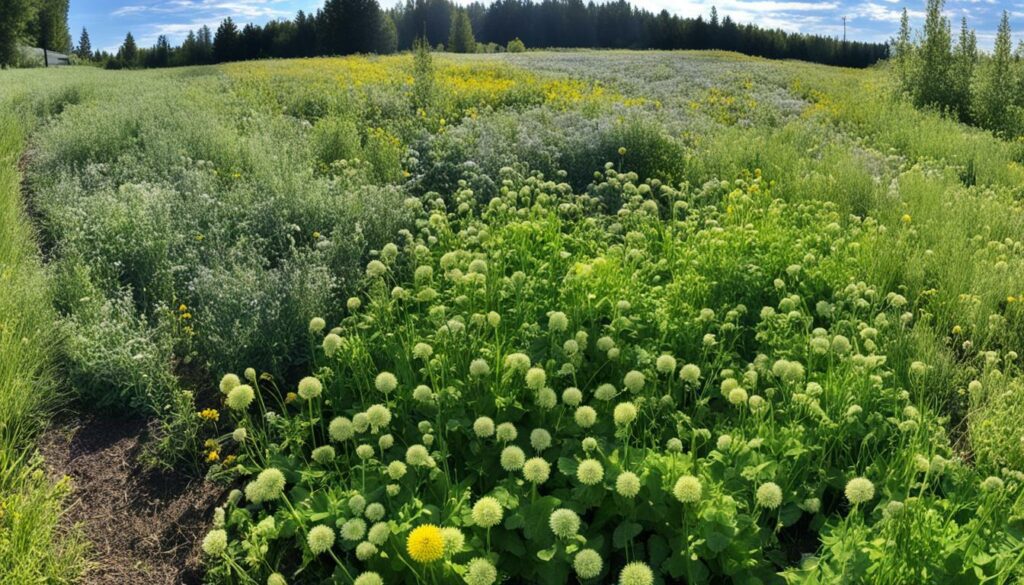
Studies show higher CO2 levels can increase a C3 weed’s biomass by 65%. This fact has caused a 39% decrease in soybean seed yield. Also, a 3°C temperature increase helps itch grass grow more. With agriculture contributing 30% of greenhouse gases, these challenges are crucial.
Seeds staying in soil make weed infestations happen again. So, controlling them might need more herbicide. Also, annual weed species grow more through seed production. Knowing when weed seeds will sprout is key, especially in summer, with soil temperature making a big difference.
Warmer weather can make plant leaves tougher, which stops herbicides from working. But, rain can help herbicides stick better by cleaning leaves and opening up cuticles. Yet, too much dryness can harm herbicide efficiency too.
Using the right planning and tools can boost the effectiveness of weed control methods. Additives like ammonium sulphate, wetters, and oils can help a lot, up to 20%. Tackling environmental factors is central to good weed control.
| Environmental Factor | Impact on Weed Control |
|---|---|
| Elevated CO2 | 65% increase in C3 weed biomass |
| Higher Temperature (2-4°C) | 3°C rise increases itch grass growth rate |
| Soil Moisture | Affects herbicide absorption and weed stress levels |
| Rainfall | Improves herbicide absorption by cleaning leaf surfaces |
Effective weed management depends on the right timing during the growing season. By knowing when weeds grow and matching your control efforts, you can do a better job at keeping them in check.
Weed control works best when you target the plant’s weak points. A guide says the best times to use herbicides are early spring and fall. Weeds are more active and easier to kill then. But don’t treat warm-season grasses in spring or when it’s hot outside. Herbicides can hurt your lawn when it’s dry.
It’s also key to check the soil and weather before you treat. Water your lawn well a day or two before. Don’t cut the grass too close to the treatment.
Figuring out when to sow seeds and apply sprays is crucial in weed fighting. Using a technique like stale seedbed farming can help. You till early to make weed seeds grow, then apply herbicide. This method works great late April to early May for stopping weeds like ragweed.
Delaying tilling for three to four weeks can help prevent weed growth. Make sure to plant seeds and apply herbicide at the right times to keep weeds from sprouting. Using the right amount of spray and knowing your weeds makes a big difference. It cuts down on waste and makes your effort more effective.
“Using the wrong herbicide can result in wasted money and ineffective weed control, highlighting the importance of timing weed control efforts accurately.”
A good plan ensures your weed-control efforts work well and your lawn stays healthy. This promotes better growth and a nicer garden.
| Strategy | Description |
|---|---|
| Spring Applications | Use weed killers during this period when weeds are actively growing. |
| Summer Adjustments | Focus on cooler times of day and ensure proper soil moisture before application. |
| Fall Treatments | Optimal time for applying herbicides for winter control. |
| Stale Seedbed Technique | Early tillage to stimulate weed seed emergence followed by herbicides. |
Integrated weed management (IWM) combines different strategies for sustainable weed control. It uses mechanical, cultural, chemical, and biological ways to fight weeds. Doing so, it doesn’t rely solely on one method. This leads to better and longer-lasting results.
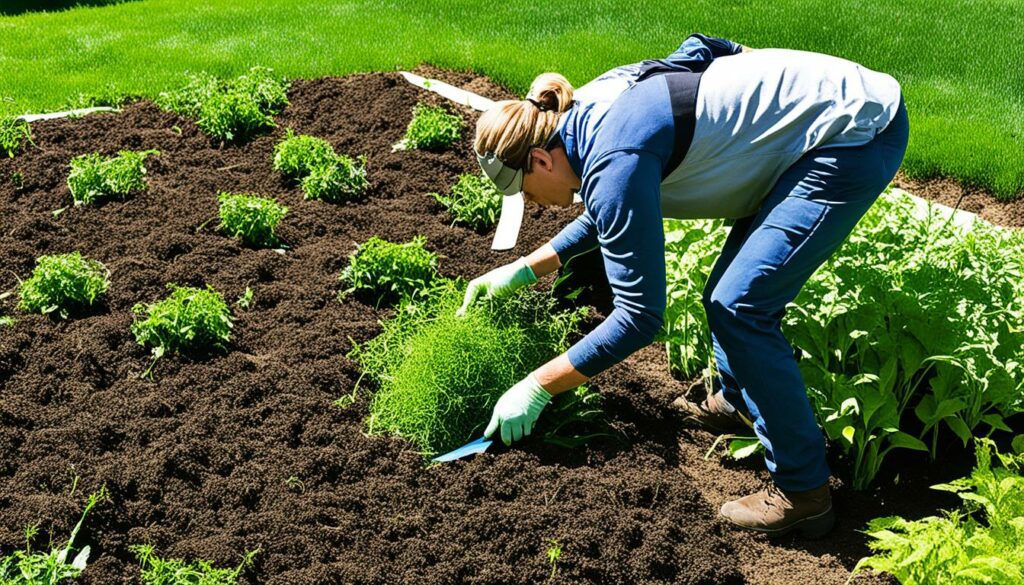
IWM uses a mix of practices to cut down on weed growth. It includes things like pulling weeds by hand, tilling the soil, mowing, and using machines to weed. These can be supported by strategies such as changing the space between crop rows, switching types of crops each season, and planting cover crops. Also, using the right herbicides can work together with natural enemies of weeds, like bugs or bacteria.
Stopping weeds from becoming resistant to herbicides is key. To do this, we should understand how herbicides work. Tactics include changing the herbicides used, managing their use to work best, and using non-chemical methods whenever we can.
| Herbicide Group | Resistance Level | Example Weeds |
|---|---|---|
| Group 1, 2, 5 | High-level resistance | Rigid ryegrass, horseweed |
| Group 4, 9, 14, 22 | Low-level resistance | Waterhemp, prickly lettuce |
Using a mix of herbicides before and after weeds appear, at the right time and amount, is critical. Paired with cultural and mechanical steps, this improves the chance of IWM working for a long time.
Research shows bad weed control can halve the amount of corn and soybeans we grow. It shows how using IWM is vital to both keep weeds down and grow good crops.
IWM helps farmers and gardeners have stronger, more productive fields. It fights herbicide resistance and supports farming that’s good for the long term.
To handle summer weeds well, you must understand the season’s unique challenges. It’s often very hot, over 85 degrees Fahrenheit. This means some weed killers can harm the plants you want to keep. It’s crucial to use methods that don’t risk your garden. For example, using some herbicides in spring can stop weeds before they grow.
The best way to deal with weeds in summer includes not just chemicals but also manual methods. Pulling weeds out by hand or digging them up works well. Using liquid weed killers just where the weeds are can be helpful too. But, you must be careful not to harm your other plants. Tools like weed torches and pullers make weed removal easier and less tiring.
Experts also suggest using ploughing smartly can help. Doing it early or late in the summer can mess up weed growth. This, along with planting crops in a certain order, can reduce how many weeds will come back. Techniques from experts like Matt Liebman and Eric Gallandt encourage using a mix of methods to control weeds well. By following these steps, your lawn will be healthier and ready for the heat of summer.
To tackle summer weeds, use pre-emergence herbicides and care for the soil. Also, keep them in check with regular mowing and smart mulching.
The heat can make herbicides less effective and stress the grass. It’s tough to fight weeds and keep the plants you want healthy.
Look out for crabgrass, yellow foxtail, and yellow nutsedge in the summer. Knowing these weeds is key to stopping them.
Stop weed seeds from growing by using pre-emergent herbicides. Also, use methods that discourage weeds from coming up.
For targeted control, use selective herbicides. They won’t hurt your plants. Ingredients like 2,4-D and quinclorac are common.
Spray when it’s cooler, sticking to product temperature advice. Mix herbicides carefully to limit any damage to the grass.
Hit annual grasses early with herbicides for the best results. Using them right, along with fertilisers, can make a big difference.
Work on perennial weeds after they’ve begun growing. This tackles their root structures. Know that you’re up against tough plants.
Combine the right herbicides with good habits for your best shot. Keep track, so you can change your approach as needed.
Follow the instructions to avoid using too much. And always protect yourself and your lawn when applying these chemicals.
Temperature and moisture play big roles in herbicide success and grass health. Use products wisely to avoid problems.
Know the weeds’ cycle to plan your attacks well. Sync your herbicide use with planting to beat the weeds at key moments.
Use a mix of tools and techniques for lasting results. This way, you can avoid weed resistance and maintain your garden’s health.